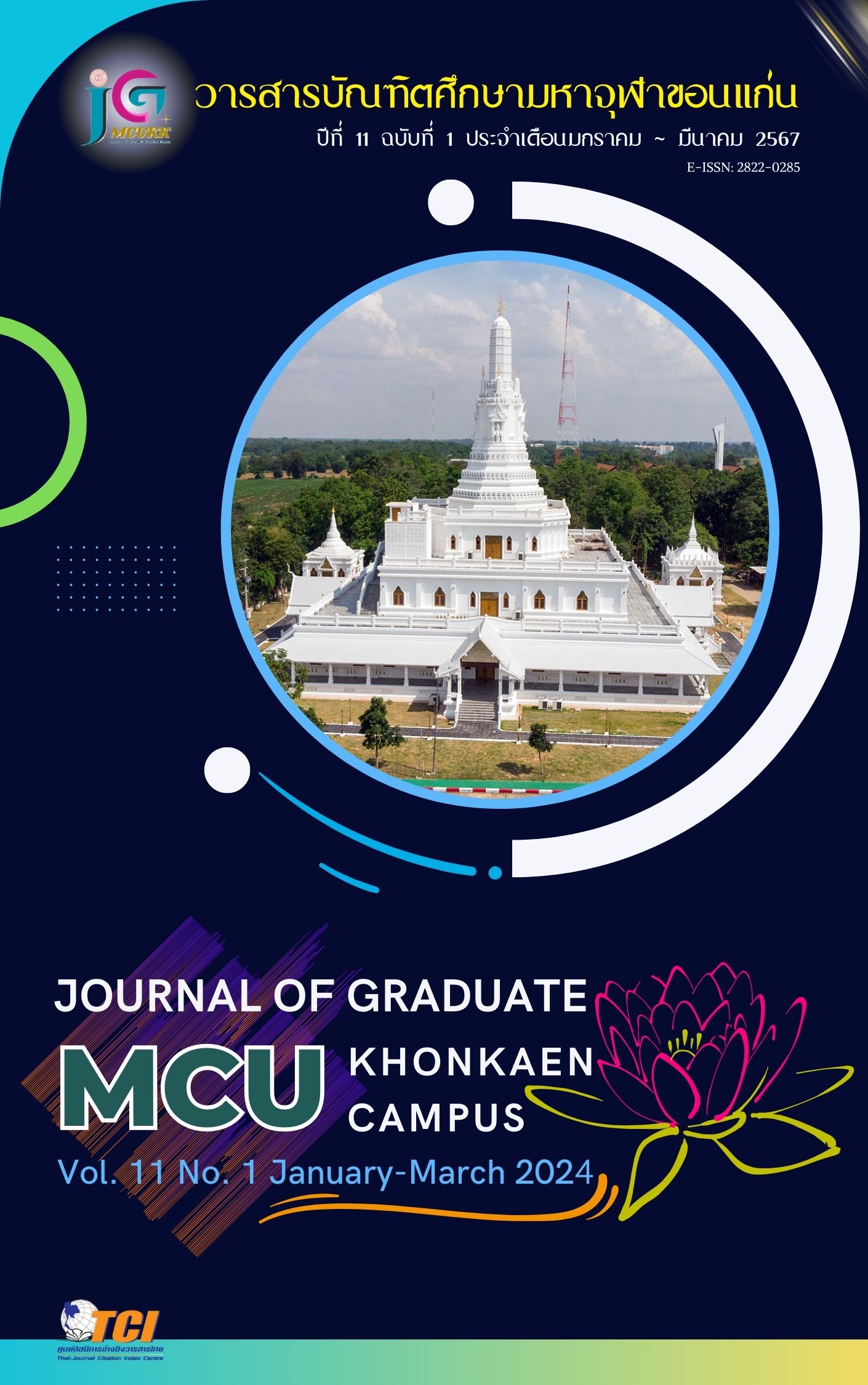Integration of The Beliefs of Building a Chapel According to Theravada Buddhist Philosophy of Temples in Kalasin Province
Main Article Content
Abstract
The purpose of this research is to 1) Study the concept of beliefs about building a chapel. 2) Study the principles of Buddhist philosophy related to beliefs about building a chapel. 3) Integrate beliefs and beliefs about building a chapel according to Theravada Buddhist philosophy of temples in Kalasin Province and 4) Present knowledge about the integration of beliefs and beliefs in building chapels according to Theravada Buddhist philosophy of temples in Kalasin Province. By mainly studying and analyzing information from the Tripitaka, textbooks and related documents, and conducting in-depth interviews. From the Sangha Administrators with knowledge and expertise in the Bun Berk Fa tradition, 5 monks and Buddhist experts/religious scholars, 5 monks/person, totaling 10 monks/person, content data was analyzed. Present descriptive information
The research results were as follows:
1. The concept of belief in building a chapel. As faith increased in the Buddhist community, there was an increased demand for building temples and chapels.
The chapel is a unique and important building. It is a place where the Buddha image representing the Lord Buddha is enshrined, where it is raised to perform the Patimokkha, and as a place for ordination for Buddhists who wish to enter the kasavapastra umbrella. To practice practices that purify the body, speech, and mind according to the principles of faith in Buddhism.
2. Principles of Buddhist philosophy regarding the beliefs and beliefs of building a chapel. Principles of faith: “Saddha, saddhana, saddha” means belief. The name faith has 9 elements: karma faith, belief in karma, belief in the law of karma, vipka faith, belief. The results of karma, karma sakta faith Believe that animals have their own karma. and Tathagata Bodhisattva
3. Integrate beliefs in building a chapel according to Theravada Buddhist philosophy of temples in Kalasin Province, that is, a chapel is an aesthetic element made from bricks, stones, cement, and sand fused together. Create and shape beauty that is evident and valuable. connected to the spirit It gives rise to the power of faith, leading to the creation of Punyakhet, called the land of merit that appears in its fullness, like a castle on the earth. The way of Buddhism, which is a sacred land, is unique and is a royal area bestowed by Wisungkhamsima. This creates special rights for the Buddhist community. By interaction, that is, bringing the principles of Buddhist philosophy into practice. bring about peace Pure in body, speech and mind, therefore it is a miracle in Buddhism. freedom from bondage Escape from suffering and reach happiness, which is eternal beauty.
4. Gained new knowledge called “CPBV MODEL” C = Capel is the construction of an ordination hall in a temple in Kalasin Province, P = Principles is the principles in Buddhism that affect beliefs in building an ordination hall, including the principles of faith, Utility, Anussati and Ariyawat, B = Belief refers to beliefs and beliefs in building the chapel and V = Virtue refers to the benefits gained from building the chapel.
Article Details

This work is licensed under a Creative Commons Attribution-NonCommercial-NoDerivatives 4.0 International License.
References
ทัศนีย์ พิกุล. (2513). ทรวดทรงและการตกแต่งโบสถไทย. (วิทยานิพนธ์ศิลปศาสตรบัณฑิต). กรุงเทพฯ: มหาวิทยาลัยศิลปากร.
เผด็จ สุขเกษม. (2535). รูปแบบสิมที่พบในจังหวัดหนองคาย. (วิทยานิพนธศึกษาศาสตรมหาบัณฑิต). มหาสารคาม: มหาวิทยาลัยศรีนครินทรวิโรฒมหาสารคาม.
ฝ่ายวิชาการภาษาไทย. (2553). พจนานุกรมไทยฉบับทันสมัยและสมบูรณ. กรุงเทพฯ: บริษัท ซีเอ็ดยูเคชั่น จำกัด มหาชน).
พระครูวชิรธรรมารม (วิเชียร ชินทตฺโต). (2556). ศึกษารูปแบบและคุณค่าของอุโบสถในพระพุทธศาสนาเถรวาท. (วิทยานิพนธ์พุทธศาสนามหาบัณฑิต).
พระนครศรีอยุธยา: มหาวิทยาลัยมหาจุฬาลงกรณราชวิทยาลัย.
พระมหาไพบูลย์ วิปุโล (เลิศฤทธิ์ธนะกุล). (2550). การศึกษาแนวคิดเกี่ยวกับเสนาสนะในพระพุทธศาสนา. (วิทยานิพนธ์พุทธศาสตรมหาบัณฑิต). พระนครศรีอยุธยา: มหาวิทยาลัยมหาจุฬาลงกรณราชวิทยาลัย.
ลานธรรมจักร. (2562). พระราธเถระ เอตทัคคะในทางผู้มีปฏิภาณแจ่มแจ้ง. สืบค้นเมื่อ 25 มิถุนายน 2566, จาก http://www.dhammajak.net/forums/viewtopic.php?f=70&t=57955
สุรพศ ทวีศักดิ์. (2560). ความ (ไม่) เป็นสมัยใหม่ : ความเปลี่ยนแปลงและย้อนแย้งของไทยกรุงเทพฯ: สยามปริทัศน์.

